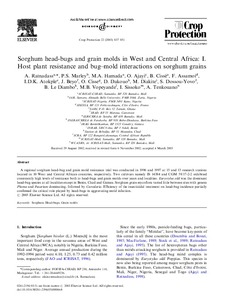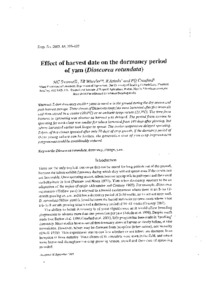Welcome to the International Institute of Tropical Agriculture Research Repository
Journal and Journal Articles: Recent submissions
Now showing items 1241-1260 of 5157
-
Potential of ethyleneproducing pseudomonads in combination with effective N2fixing bradyrhizobial strains as supplements to legume rotation for the control of Striga hermonthica
(2003)Striga hermonthica (Del.) Benth. is an obligate, root-parasitic, flowering plant that limits cereal production in sub-Saharan Africa.Successful control depends on eliminating its seed reserves in soil, thereby preventing parasitism. Striga hermonthica seeds germinate only if adequately conditioned and exogenous stimulant initiates ethylene production within the seed, or if ethylene is directly supplied to the conditioned seed.Since S. hermonthica is an obligate root parasite, stimulating the seeds ... -
Amelioration de la gestion des sols par lintroduction de legumineuses dans les systemes cerealiers des savannes africaines
(2003)Lessons for appropriate soil management technology generation for the savannas and their application to the grain legume-cereal rotation system There are many legume-based techno logies capable of regenerating soi l ferti lity but few are being adopted by fa rmers in West Africa . At the Tn ternationa l Institute of Tro pica l Agriculture (TTTA) we found that alley cropping and cover cropping systems are biologica ll y sustainable but have low adoption by farmers in the medium term. Negacive ... -
Plantparasitic nematodes associated with root and tuber crops in Uganda
(2003)In a nematode survey of eight commonly grown root and tuber crops (cassava, sweet potato, potato, yam, tannia, taro, carrot and turmeric) from 430 fields in Uganda, 69 species of plant-parasitic nematodes representing 28 genera were extracted from soil and roots. About twice as many nematode species were recovered from soil (64) as from roots (36), while 32 species were found only in soil and four species only in roots, usually in mixed populations. Meloidogyne spp. (root-knot nematodes) were the ... -
Field evaluation of cowpea cultivars (Vigna unguiculata L Walp.) for resistance to flower thrips (Megalurothrips sjostedti Trybom) (Thysanoptera: Thripidae)
(2003)Ten cowpea cultivars were screened for resistance to flower bud thrips, Megalurothrips sjostedti, in replicated field trials. Resistance was evaluated by measuring differences in populations and visual damage on the cultivars. Statistical correlation was employed to assess the degree of association between damage indices and thrips population in the cultivars for each season. In the first season cultivars were conveniently grouped into three, using damage indices and thrips populations size. In ... -
Synergistic relationship of bacterial blight and anthracnose disease pathogen in cassava multiple infection
(2003)A study was conducted at the greenhouse of the international institute of Tropical Agriculture, Ibadan,Nigeria to investigate the synergistic relationship of xanthomonas campestris pv. Manihotics (causal agent of cassava bacteria blight CBB), and colletotrichum gloeosporiodes f.sp manihotics (causal agent of cassava anthracnose disease CAD), in cassava multiple infection. There were statistical differences(p<0.05) in the cassava genotype following sequential inoculation of the pathogens and ... -
Induction of germination in dormant yam (Dioscorea spp.) tubers with inhibitors of gibberellins
(2003)A reliable means to induce sprouting in dormant seed tubers of yams (Dioscorea species) is required to enhance flexibility in planting date and rate of propagation of the crop. Experiments were conducted to assess the potential of two gibberellin inhibitors, Uniconazole-P and Prohexadione-calcium, to induce sprouting in tubers from three varieties ofD. rotundata and four ofD. alata. Uniconazole-P and Prohexadionecalcium shortened the period of dormancy in tubers of some varieties. In others, they ... -
Effects of cassava genotype, climate, and the Bemisia tabaci vector population on the development of African cassava mosaic geminivirus (ACMV)
(2003)A survey was carried out in the 1996/97 and 1997/98 growing seasons on a field planted in three replicates with five clones of cassava at the International Institute of Tropical Agriculture, Ibadan, located in a transition forest, to determine the effects of cassava genotype and climate on the development of African cassava mosaic geminivirus (ACMV) and changes in the Bemisia tabaci population. Cassava genotype, climate and their interactions have significant -
Sorghum headbugs and grain molds in West and Central Africa; I: host plant resistance and bugmold interactions on sorghum grains
(2003-07)A regional sorghum head-bug and grain mold resistance trial was conducted in 1996 and 1997 at 15 and 13 research stations located in 10 West and Central African countries, respectively. Two cultivars namely IS 14384 and CGM 39/17-2-2 exhibited consistently high levels of resistance both to head-bugs and grain molds over years and localities. Eurystylus oldi was the dominant head-bug species at all localities except in Benin, Chad and Guinea. Sorghum grain mycoflora varied little between sites with ... -
Economic impact of biological control of water hyacinth in southern Benin
(2003-02)A biological control program of water hyacinth was undertaken in Southern Benin between 1991 and 1993. It consisted of the release of three natural enemies, two weevil species and one moth, that feed exclusively on water hyacinth. In 1999, a survey of 365 men and women from 192 households in 24 villages in the target area, using participatory and quantitative methods, revealed that water hyacinth, although not eliminated, was perceived by the villagers as having been reduced from a serious pest ... -
Development of an integrated laboratory information management system of the maize mapping project
(2003-11)Motivation: The development of an integrated genetic and physical map for the maize genome involves the generation of an enormous amount of data. Managing this data requires a system to aid in genotype scoring for different types of markers coming from both local and remote users. In addition, researchers need an efficient way to interact with genetic mapping software and with data files from automated DNA sequencing. They also need ways to manage primer data for mapping and sequencing and provide ... -
Host plant resistance to insects: an ecofriendly approach for pest management and environment conservation
(2003)Host plant resistance (HPR) to insect is an effective, economical and environment friendly method of pest control. The most attractive feature of HPR is that farmers virtually do not need any skill in application techniques, and there is no cash investment by the resource poor farmers. Considerable progress has been made in identification and development of crop cultivars with resistance to the major pest in different crops -
Plant breeding successes in African rural development.
(2003-04-02)This article reviews improvements in important southern African food crops, and it describes the social and economic effects of those improved crops. Author Rodomiro Ortiz, the acting Deputy-Director General of the International Institute of Tropical Agriculture (IITA), says that the development and distribution of high-yielding cassava cultivars led to a 50 percent increase in average yield and a 10 percent increase in per capita output throughout Africa. Meanwhile, Ortiz says that improved maize ... -
Food yams in Africa
(2003) -
Genetic diversity of organoleptic properties in water yam (Dioscorea alata L.)
(2003)Improving the food quality of yams (Dioscorea spp) is an ongoing challenge to yam breeders and researchers. Forty accessions of D alata were evaluated for the suitability of their tubers for the preparation of two dominant food forms (boiled and pounded) as part of an effort to identify potential parents for use in genetic improvement. Trained panellists were presented with randomised, replicated and coded samples of boiled yam tuber pieces and asked to rate them for mealiness, colour, wetness, ... -
Effect of harvest date on the dormancy period of yam (Dioscorea rotundata)
(2003-06)Tuber dormancy enables yams to survive in the ground during the dry season and post‐harvest storage. Three clones of Dioscorea rotundata were harvested after five intervals and then stored in a cooler (20.6°C) or at ambient temperature (27.8°C). The time from harvest to sprouting was shorter as harvest was delayed. The period from sowing to sprouting for each clone was similar for tubers harvested from 140 days after planting, but tubers harvested earlier took longer to sprout. The cooler temperature ...





